This piece originally appeared in the Washington Post.
The recent wave of voter suppression laws has rightly drawn much attention. But another, even more pernicious wave of anti-voter laws will begin shortly: the redrawing of congressional maps. Unless Congress acts quickly, Americans are on the verge of some of the most aggressive gerrymandering in the country’s history. Inevitably, communities of color, which provided almost all of the country’s growth over the past decade, will bear the brunt of this anti-democratic line-drawing.
As Democrats finalize a new version of reform legislation to replace the For the People Act, it is essential, as Sen. Joe Manchin III (D-W.Va.) recognized in June, that the measure include a provision to “ban partisan gerrymandering,” drawing district lines that unfairly enhance the representation of the party in power.
Such a ban — along with beefed-up remedies for abuses and uniform standards for drawing maps, including strengthened protections for communities of color — would amount to the most consequential federal redistricting legislation in history. But unlike other parts of voting legislation that might not come into play until 2022 or later, redistricting reforms cannot be put off.
On Aug. 16, the Census Bureau releases map data to states. After that, states are expected to rush to complete maps. Eighteen states, including Texas, Ohio and North Carolina, face tight fall deadlines for completing maps. Another 14 states, including Georgia and Tennessee, also could pass new maps by the end of the year or shortly thereafter based on historic practices. In a matter of weeks, the process will be over in most of the country.
Why the new sense of urgency? Many Democrats were alarmed by reports that White House aides believe it is possible to “out-organize” Republican voter suppression efforts. But here’s the reality: You cannot out-organize a well-crafted gerrymander. Once manipulated maps are drawn, they will be almost impossible to overcome.
The evidence from the past decade makes that clear. In 2011, Republicans in Pennsylvania passed a congressional map that divided communities to engineer a GOP lock on 13 of the state’s 18 congressional districts. It worked. In 2012, Democrats won 51 percent of the statewide congressional vote but secured only five congressional seats. The Pennsylvania map was so durably gerrymandered that even if Democrats won a historically high 56 percent of the congressional vote, they would capture only six seats. (By contrast in 2006, when Democrats won 56 percent of the vote under the prior map, they won 11 congressional districts.)
A similarly gerrymandered map in Ohio has held Democrats to just four of the state’s 16 congressional districts all decade, while maps in North Carolina gave Republicans a 10-to-3 advantage for most of the decade. All told, the Brennan Center estimates that last decade’s extreme gerrymandering gave Republicans an extra 15 to 17 seats in Congress. Wins in court were able to dial back some of this advantage, but litigation consumed much of the decade. North Carolina did not receive a new, fairer map until the 2020 election.
What can we expect going forward? In the South, where most of the redistricting hot spots are located, gerrymanders historically have come at the expense of communities of color. This cycle could be even worse.
Most people of color in the country’s metro areas now live in the suburbs rather than in traditional majority-minority districts in inner cities. Here, a new type of minority power has begun to emerge as multiracial coalitions have come together around cities such as Atlanta, Dallas and Houston. But these districts are not protected by voting rights laws as interpreted by the Supreme Court and will likely be dismantled by partisan map-drawers in redistricting. The damage will last a decade.
Federal legislation would transform how congressional districts are drawn, stepping in where the Supreme Court has stepped out, to restore fairness to the process and strengthen frayed legal protections for communities of color. It also would make it easier and faster for voters to challenge politically or racially discriminatory maps in court, and for the first time require meaningful transparency in a process that historically has taken place behind closed doors.
But the longer it takes to pass federal legislation, the harder it will be to fully implement its reforms. For example, the transparency provisions of the bill would be impossible to implement after the fact. That would allow lawmakers to hide maps from the public and then cram them through in a matter of hours, as happened in Pennsylvania in 2011.
When the Supreme Court ruled in 2019 that courts would not intervene to stop partisan redistricting, Chief Justice John G. Roberts Jr. pointed the way to a solution: “The Framers gave Congress the power to do something about partisan gerrymandering.” Congress and the Biden White House need to make saving the redistricting cycle an urgent priority. Every vote should count equally — and every day matters to ensure that happens.



